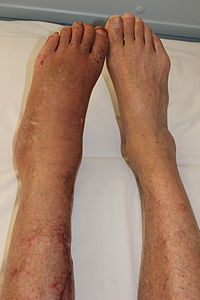
Photo from wikipedia
ABSTRACT Introduction Patients with sickle cell disease (SCD) present recurrent episodes of acute pain, the hallmark of the disease, and some will also develop chronic pain. Currently, the treatment of… Click to show full abstract
ABSTRACT Introduction Patients with sickle cell disease (SCD) present recurrent episodes of acute pain, the hallmark of the disease, and some will also develop chronic pain. Currently, the treatment of SCD acute pain only targets its symptoms, rather than underlying mechanisms, and is directed by expert and consensus guidelines. Areas covered While opioids remain the mainstay of therapy for acute pain and are also used to treat SCD-related chronic pain, in some patients, opioids are ineffective or are associated with severe undesirable side effects. In those instances, clinicians caring for patients with SCD face an unmet need for effective non-opioid analgesics. Recently, the use of subanesthetic ketamine has been explored as a strategy to meet this need. While definitive evidence of its efficacy is lacking, some information exists suggesting that subanesthetic ketamine improves pain control and may have opioid-sparing effects in SCD-related acute pain. However, ketamine can also yield undesirable psychotomimetic and cardiovascular effects. Expert opinion After weighing potential risks and benefits, in the absence of better alternatives and in settings where it can be administered safely, ketamine may be a reasonable option for patients with SCD-related acute refractory pain.
Journal Title: Expert Review of Hematology
Year Published: 2022
Link to full text (if available)
Share on Social Media: Sign Up to like & get
recommendations!